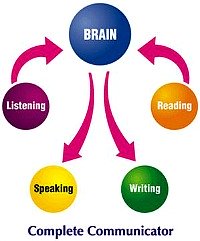 |
Learn English Locally, Apply It Worldwide! Enjoy Regular Practice |
'Class-Yes' Is the Most Imaginative Attention Getter Ever!
'Class-Yes' is the simplest, yet the most compelling of all the techniques in WBT.
When the teacher says 'Class!' the students respond saying 'Yes!' mimicking the tone of voice and the length of the one-syllable word uttered by the teacher.
What this does, is to activate the prefrontal cortex, the brain's CEO controlling the decision making, planning and focus of attention. In one word, this dialogue, performed correctly, grabs the students' attention at any moment in time during the class. Without the prefrontal cortex of the brain engaged, little or no learning can be going on, as the learning process requires a conscious decision on the part of the students to do so. The 'Class-Yes' interaction gets the students ready for listening to instructions to follow, with a receptive brain, curiosity being the main ingredient.
Script for the 'Class-Yes' technique
Here's how to get started with this fabulous attention getter. It's all based on a dialogue between the teacher and the students. It goes like this:
Teacher: When I say 'Class!' ... You say 'Yes!' [Pause] ... Class!
Students: Yes!
Teacher: However I say 'Class!', that's how you say 'Yes!' [Pause] ... Class! Class!
Students: Yes! Yes!
Teacher: Classity! Class!
Students: Yesity! Yes!
And that's as simple as it gets! It takes less than a minute to get everybody to understand this technique. After a few repetitions, you explain to the students that the tone of voice and the length of the teacher's expression is to be followed literally. So, if you say 'Class' in a long, lingering, high-pitched voice, that's how they would say 'Yes' as well. If you give them an army-like command - 'Class! Class!' that's how they should answer and soon they get used to it and have fun in answering.
This is actually the trick - the fun in this simple interaction has the power to stop the students doing anything else, whether it's following a previous instruction of yours, or just being disruptive and pay attention to what you're going to say next, with their hands clasped together in listening position and eyes on you. It works! Of course, it works better if the teacher is genuinely involved and not just producing the required noise, but we assume that's the case anyway.
Variations on a theme
One variation could be by engaging the student leader in charge of 'Class-Yes'. Whenever you need or want to attract their attention, you point at the student leader (who, by the way, should be more focused on you than anybody else in the classroom, ready to take on the role as needed) and (s)he will then say 'Class!', to which the other students will respond 'Yes!' appropriately.
Another variation could be by using extremely funny expressions - one teacher used 'Class-a-doodle-doo!' to which the students responded 'Yes-a-doodle-doo!' and smiled. Smiling is important in the process of learning, as it activates the limbic system in the brain, in charge of one's emotions. If your students remember a good feeling they had in your class, they will come to your class more light-heartedly and they will be more receptive to your instructions - that's a fact!
Think about it - you're not going to lose more time in doing this than you would lose if you had to discipline some or all of your students from time to time... bless the teachers who're constantly 'at it'!
Variations
is important in using this technique, for otherwise the students will
become habituated and will not respond anymore to the same stimulus. All
of us have been there - remember? A technique that worked wonderfully
in September can be 'dead wood' by May-June!
A few examples of variations are those based on the pitch of the teacher's voice (high, low), the speed (fast or slow), repetitions (you say it once or more/many times), gestures (none, small gestures or dramatic gestures).
Another variation used by teachers worldwide is the use of core knowledge instead of the instruction 'Class!' in more advanced level classes. It works a bit like this: when you say '4x4' they say '4x4 is 16' or you say 'top number in a fraction' they say 'numerator'. An added complication is to use various quiz-like questions for this, during the course of a class.
Why is 'Class-Yes' important? Is it not just some monkeying around in the class?
Oh, no! This is a simple, entertaining technique to gain students' attention ... over and over again during the course of the class. It can mark the changing point from one activity to the other, or it can simply be used when the class is getting out of hands a little bit. Anyway, a teacher can't teach until the students are listening. One can try, but don't expect results.
What should we use 'Class-Yes' for?
One can use the 'Class-Yes' technique to start/finish a class, to interrupt a class activity, to reduce the hub-hub, for crowd control and for many other purposes. It's simple and effective.
You can even integrate the 'Class-Yes' technique into your lesson plan! The teaching part of a lesson plan can be reduced to a simple 3-column sheet, with the timing of your 'Class-Yes' attention getter on the left, the content of your micro-teaching session in the middle column (no longer than 3 sentences, as the students' short term memory is only 15 to 20 seconds), followed by your timing of your next instruction - the whole brain activator 'Teach-OK!' on the right.
Why should we use it?
- It's quicker than other attention getter techniques - it should take up to 3 seconds to 'electrify' the class with it;
- It echoes the teacher's request for attention, even amplifying the volume of the signal;
- The variety of voices and cadence of the instruction is actually entertaining;
- It's
magic: something wondrous is turning on in students' brains, as if
they're programming themselves to acquiesce receiving new knowledge or
instructions;
- And it's crazy fun!
Teaching the 'Class-Yes' technique before you even step into the classroom!
On the official Whole Brain Teaching website there is a library of teacher training videos, in the middle-left side of the home page. In there you will find the "Program 514 - Class Yes" which, for a duration of 52 minutes will teach you the ropes of this powerful technique.
Equally, on the same page, you can access the video for "Program 532 - The First Hour", which will virtually give you everything you need to set up a fun and memorable first hour, not only for the new students on board. In this video you get to find out about the what I call 'magic' first hour - magic, because your students won't even realise they're being taught something, in a group outside the classroom. You teach them 'Class-Yes' and prepare them to enter the sacred learning space (well prepared in advance as well) which is their classroom.
How to use the 'Class-Yes' technique for rowdy cliques
This is a beauty! The strategy is simple enough, but you do need some experience with it.You:
- split the Rowdies up and you 'salt' them among loyalist groups;
- you then use a silly voice for your 'Class-Yes' - Rowdies love silly;
- use a "Raise me 'Class'" - they would need to say 'Yes' louder than you said 'Class';
- stand next to the weakest Rowdy when you say 'Class' (s)he will respond positively;
- use the Birthday Game to select the most popular, loyal student to be the 'Class' leader;
- once you have a talking relationship with a Rowdy, take him/her aside and ask if (s)he wants to be a leader for the 'Class-Yes' technique;
- to lighten the atmosphere in the classroom, you can address your students with "my friends" - it's been tried, with surprisingly good results!
Other techniques are available for classroom management, which you'll find elsewhere on this website.
If the 'Class-Yes' doesn't work, having repeated 'Class' for two, maximum three times, one must use the Scoreboard for re-instating discipline in the classroom.
Strengths and weaknesses of the 'Class-Yes' attention getter technique
|
Strengths The best aspect of this technique is that it activates the limbic system in students' brains - the feel-good factor. If you use it frequently enough, you can keep your students in a constant state of feeling good and this goes a long way... sometimes even years after one has graduated from school! |
Weaknesses I cannot think of particular weaknesses, apart from perhaps the monotony in the classroom, if one doesn't use the variations suggested in this course. Maybe older and more serious students would find it a bit childish, but even they are OK, once they realise the logic behind the technique. |
English Corner Weekly E-zine
Packed with knowledge, published on Tuesdays.
Get yours here!
Our Archives:
Our lessons in the names and sounds of letters, short & long vowel sounds, CVCs, CCVCs, CVCCs, sight words, vowel and consonant contrasts, etc.
Our lessons will help increase your vocabulary, word recognition, find meaning in context, skills for TOEFL tests and other games, for fun.
Here we shall build some lessons to help you improve your writing skills.
Lots of lessons: cause & effect, comparisons, linking signals, relative clauses, presenting information, expressing emotions and grammar games, of course. We had more lessons on: intensifying adverbs and phrasal verbs, expressing various concepts such as addition, exception, restriction and ambiguity. Lately we started some exercises: likes/dislikes, frequency adverbs (twice), verb tenses, etc.
Learn how to build a website, by using the SBI! system - start from the basics, developing a site concept and a niche, supply and demand, learn about profitability and monetization, payment processing, register domain, website structure and content as a pyramid. Also learn about the tools I'm using to build this website. We also covered how to build traffic, working with search engines, building a good system of inbound links, using social marketing and blogs with the SBI system, how to use Socialize It and Form Build It, how to publish an e-zine and how to build a social network in your niche.
We looked at a few games by now: Countable & uncountable nouns, Free Rice, Name That Thing, Spell It, Spelloween, the Phrasal Verbs Game, Preposition Desert, The Sentence Game, Word Confusion, Word Wangling, Buzzing Bees, and The Verb Viper Game.
Be prepared to play and learn more pretty soon.
